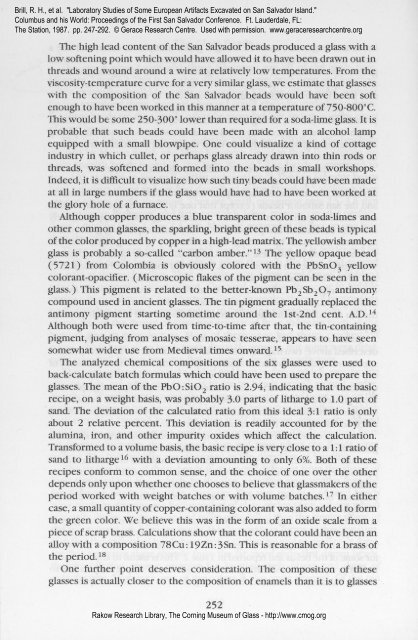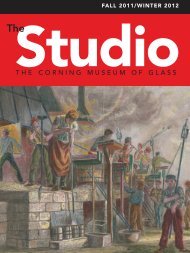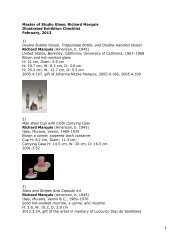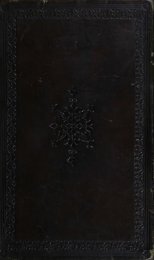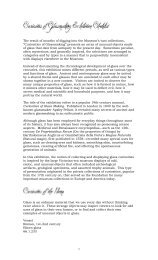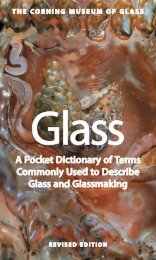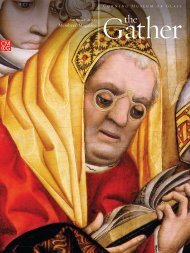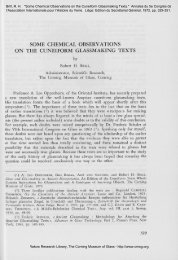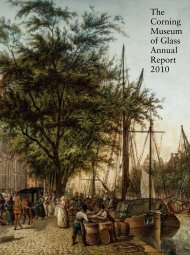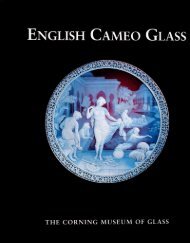"Laboratory Studies of Some European Artifacts Excavated on San ...
"Laboratory Studies of Some European Artifacts Excavated on San ...
"Laboratory Studies of Some European Artifacts Excavated on San ...
Create successful ePaper yourself
Turn your PDF publications into a flip-book with our unique Google optimized e-Paper software.
Brill, R. H., et al. "<str<strong>on</strong>g>Laboratory</str<strong>on</strong>g> <str<strong>on</strong>g>Studies</str<strong>on</strong>g> <str<strong>on</strong>g>of</str<strong>on</strong>g> <str<strong>on</strong>g>Some</str<strong>on</strong>g> <str<strong>on</strong>g>European</str<strong>on</strong>g> <str<strong>on</strong>g>Artifacts</str<strong>on</strong>g> <str<strong>on</strong>g>Excavated</str<strong>on</strong>g> <strong>on</strong> <strong>San</strong> Salvador Island."<br />
Columbus and his World: Proceedings <str<strong>on</strong>g>of</str<strong>on</strong>g> the First <strong>San</strong> Salvador C<strong>on</strong>ference. Ft. Lauderdale, FL:<br />
The Stati<strong>on</strong>, 1987. pp. 247-292. © Gerace Research Centre. Used with permissi<strong>on</strong>. www.geraceresearchcentre.org<br />
The high lead c<strong>on</strong>tent <str<strong>on</strong>g>of</str<strong>on</strong>g> the <strong>San</strong> Salvador beads produced a glass with a<br />
low s<str<strong>on</strong>g>of</str<strong>on</strong>g>tening point which would have allowed it to have been drawn out in<br />
threads and wound around a wire at relatively low temperatures. From the<br />
viscosity-temperature curve for a very similar glass, we estimate that glasses<br />
with the compositi<strong>on</strong> <str<strong>on</strong>g>of</str<strong>on</strong>g> the <strong>San</strong> Salvador beads would have been s<str<strong>on</strong>g>of</str<strong>on</strong>g>t<br />
enough to have been worked in this manner at a temperature <str<strong>on</strong>g>of</str<strong>on</strong>g>750-800°C.<br />
This would be some 250-300° lower than required for a soda-lime glass. It is<br />
probable that such beads could have been made with an alcohol lamp<br />
equipped with a small blowpipe. One could visualize a kind <str<strong>on</strong>g>of</str<strong>on</strong>g> cottage<br />
industry in which cullet, or perhaps glass already drawn into thin rods or<br />
threads, was s<str<strong>on</strong>g>of</str<strong>on</strong>g>tened and formed into the beads in small workshops.<br />
Indeed, it is difficult to visualize how such tiny beads could have been made<br />
at all in large numbers if the glass would have had to have been worked at<br />
the glory hole <str<strong>on</strong>g>of</str<strong>on</strong>g> a furnace.<br />
Although copper produces a blue transparent color in soda-limes and<br />
other comm<strong>on</strong> glasses, the sparkling, bright green <str<strong>on</strong>g>of</str<strong>on</strong>g> these beads is typical<br />
<str<strong>on</strong>g>of</str<strong>on</strong>g>the color produced by copper in a high-lead matrix. The yellowish amber<br />
glass is probably a so-called "carb<strong>on</strong> amber." 13 The yellow opaque bead<br />
(5721) from Colombia is obviously colored with the PbSn0 3 yellow<br />
colorant-opacifier. (Microscopic flakes <str<strong>on</strong>g>of</str<strong>on</strong>g> the pigment can be seen in the<br />
glass.) This pigment is related to the better-known Pb 2 Sb 2 0 7 antim<strong>on</strong>y<br />
compound used in ancient glasses. The tin pigment gradually replaced the<br />
antim<strong>on</strong>y pigment starting sometime around the 1st-2nd cent. A.D.14<br />
Although both were used from time-to-time after that, the tin-c<strong>on</strong>taining<br />
pigment, judging from analyses <str<strong>on</strong>g>of</str<strong>on</strong>g> mosaic tesserae, appears to have seen<br />
somewhat wider use from Medieval times <strong>on</strong>ward. IS<br />
The analyzed chemical compositi<strong>on</strong>s <str<strong>on</strong>g>of</str<strong>on</strong>g> the six glasses were used to<br />
back-calculate batch formulas which could have been used to prepare the<br />
glasses. The mean <str<strong>on</strong>g>of</str<strong>on</strong>g> the PbO:Si0 2 ratio is 2.94, indicating that the basic<br />
recipe, <strong>on</strong> a weight basis, was probably 3.0 parts <str<strong>on</strong>g>of</str<strong>on</strong>g> litharge to 1.0 part <str<strong>on</strong>g>of</str<strong>on</strong>g><br />
sand. The deviati<strong>on</strong> <str<strong>on</strong>g>of</str<strong>on</strong>g> the calculated ratio from this ideal 3:1 ratio is <strong>on</strong>ly<br />
about 2 relative percent. This deviati<strong>on</strong> is readily accounted for by the<br />
alumina, ir<strong>on</strong>, and other impurity oxides which affect the calculati<strong>on</strong>.<br />
Transformed to a volume basis, the basic recipe is very close to a 1:1 ratio <str<strong>on</strong>g>of</str<strong>on</strong>g><br />
sand to litharge 16 with a deviati<strong>on</strong> amounting to <strong>on</strong>ly 6%. Both <str<strong>on</strong>g>of</str<strong>on</strong>g> these<br />
recipes c<strong>on</strong>form to comm<strong>on</strong> sense, and the choice <str<strong>on</strong>g>of</str<strong>on</strong>g> <strong>on</strong>e over the other<br />
depends <strong>on</strong>ly up<strong>on</strong> whether <strong>on</strong>e chooses to believe that glassmakers <str<strong>on</strong>g>of</str<strong>on</strong>g> the<br />
period worked with weight batches or with volume batches. 17 In either<br />
case, a small quantity <str<strong>on</strong>g>of</str<strong>on</strong>g>copper-c<strong>on</strong>taining colorant was also added to form<br />
the green color. We believe this was in the form <str<strong>on</strong>g>of</str<strong>on</strong>g> an oxide scale from a<br />
piece <str<strong>on</strong>g>of</str<strong>on</strong>g>scrap brass. Calculati<strong>on</strong>s show that the colorant could have been an<br />
alloy with a compositi<strong>on</strong> 78Cu: 19Zn: 3Sn. This is reas<strong>on</strong>able for a brass <str<strong>on</strong>g>of</str<strong>on</strong>g><br />
the period. 18<br />
One further point deserves c<strong>on</strong>siderati<strong>on</strong>. The compositi<strong>on</strong> <str<strong>on</strong>g>of</str<strong>on</strong>g> these<br />
glasses is actually closer to the compositi<strong>on</strong> <str<strong>on</strong>g>of</str<strong>on</strong>g> enamels than it is to glasses<br />
252<br />
Rakow Research Library, The Corning Museum <str<strong>on</strong>g>of</str<strong>on</strong>g> Glass - http://www.cmog.org


